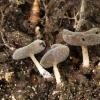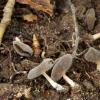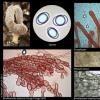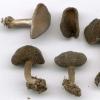
28-12-2025 12:08
Margot en Geert VullingsThis possible Karstenia was found on the bark of d

21-12-2025 21:32
Pol DebaenstHello, Garden, Burgweg 19, Veurne, BelgiumOn 10/1

26-12-2025 21:19
Arnold BüschlenPithyella chalaudii Priou. Ist als Bryoparasit in

21-12-2025 09:32
Hello.A tiny ascomycete found embedded in wood in

18-12-2025 21:17
Pol DebaenstThe identification took me to Byssonectria deformi

24-12-2025 17:08
Hulda Caroline HolteHello, I have found this propoloid ascomycete on
J'aimerais bien avoir votre aide pour identifier cette helvelle que j'ai récoltée le 13 septembre 2011 sur sol nu assez humide, sous chêne, dans la région de Montréal, Québec. Plusieurs espèces seraient possibles selon Mario Filippa (notamment ephippium, cupuliformis,) mais les caractères ne sont pas assez tranchés pour me permettre de déterminer l'espèce. J'avais d'abord déterminé mes spécimens Helvella fibrosa, mais le pied plus court que le chapeau semble ne pas coller avec cette espèce.
Voici les détails de ma récolte. J'ai vu au moins une quinzaine de spécimens, tous d'environ la même taille.
Coupe de 1-1,5 cm de largeur, 0,5-0,7 cm de hauteur; hyménium brun, lisse; face externe villeuse, grise.
Pied de 0,5-1 x 0,1-0,2 cm, blanc, finement pubescent.
Spores ellipsoïdes, lisses, monoguttulées, (16)18-20 x (10,5)12-13 µm.
Asques : 246-269 x 15 µm, sans crochets, octosporées
Paraphyses droites, un peu clavées à l'apex, 4-6 µm à l'apex.
Medulla : textura intricata (difficile à dissocier)
Revêtement externe composé de cellules ± cylindriques en chaînettes
Vous pouvez voir la planche grand format à l'adresse suivante :
http://www.flickr.com/photos/21189203@N05/6450465337/sizes/l/in/photostream/
Cordialement,
Renée Lebeuf

My first impression would be H. fibrosa (=H. chinensis, H. villosa etc.)
Morphologically most similar species is H. cupuliformis when all microscopical characters are taken into account. My collections (17 tested) of H. fibrosa has spores *17-21×10,5-12,5(13) micr. vs. H. cupuliformis (11 tested) *18-22×12,5-14(15) micr. Superficially looking, H. ephippium is quite confusing if pileal vertical median section is not mounted in CB (cotton blue). Contrary to preceeding +/- *regularly cupulate two species, H. ephippium with normally *lightly saddle-shaped pileus in full maturity, does not have upper medullar horizontal hyphae but instead it has scattered sphaerocysts. In distinction of first two, ectoexcipular wall thickness and colour are also very helpful. H. cupuliformis has cinnamomeous golden walls *0,6-1,7 micr. vs. greyish-yellow walls *0,4-0,7 micrs thick in H. fibrosa. Additionally, H. cupuliformis has much shorter abruptly *whitish stipe and different ecology. In SE Europe, H. cupuliformis is confined to Pinaceae, mostly Abies, while H. fibrosa is normally found under Quercus.
NOTE: Asterisk of course indicate living state of the character.
Cheers,
Neven

Par exclusion, ce n'est pas H. ephippium, ni H. cupuliformis, ni H. rivularis... Reste donc H. fibrosa !

Carbone M. 2011. Contributo alla conoscenza di Helvella rivularis, una specie critica e poco conosciuta della sez. Macropodes. Mycologia Montenegrina, 13 : 7-39.
Toutes ces espèces sont illustrées et comparées.
Renée
En effet, l'article dans Mycologia Montenegrina est intéressant, mais je trouve qu'on reste un peu sur sa faim car les critères de distinction entre H. rivularis et H. fibrosa sont vraiment très minces et sont peu argumentés.
Si la distinction se fait sur base de la couleur et de la villosité, il y a de nombreuses observations de H. villosa en région bruxelloise (où elle est assez commune) qui pourraient se rapporter à H. rivularis, comme par exemple cette récolte de 2000.
A contrôler sur les prochaines récoltes donc...
Cordialement,
Daniel

I must say I concur with Daniel. Indeed, we had several grey cupulate Helvella collections with longer semipigmented stipe here settled in innundation zone of some Croatian and Slovenian creeks and small rivers that someone might have called H. rivularis, but I never found any substantial differencies from "normal" H. fibrosa (in terms of vital macro- & micromorphological view, cyto- and hystochemistry) equally also in characters that are usually critically important in distingushing closely related and/or most similar Helvella species as much as in the others!
Therefore, I am so far not convinced in H. rivularis to be a separate species. However, it would be wise to at least analyze type material that still may be something different from the idea of what some workers consider to be H. rivularis! Molecular analysis would be also desirable as well.
Cheers,
Neven



